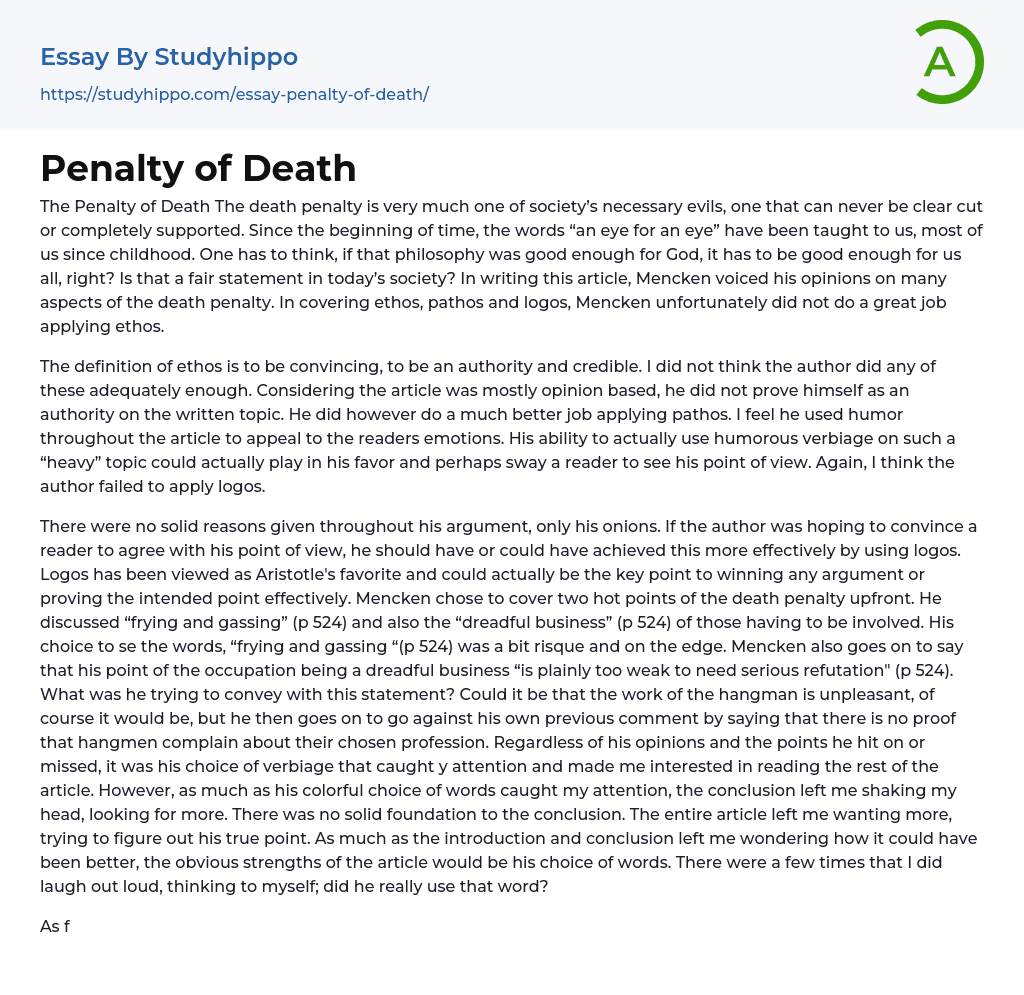Even though the death penalty is regarded as a necessary evil, it remains an unresolved societal issue that cannot be conclusively justified or completely endorsed.
Throughout history, the concept of "an eye for an eye" has been deeply ingrained in our teachings. It is commonly believed that if this principle was deemed appropriate by God, it should also be applicable in modern society. However, can we still hold onto this belief today? In his article, Mencken shares his perspective on various aspects of capital punishment. Unfortunately, when discussing ethos, pathos and logos, Mencken falls short in effectively incorporating ethos. Ethos refers to the ability to convince others and possess authority and credibility. Personally, I find that the author fails to meet any of these requirements satisfactorily.
The article lacked authority due to its opinion-based nature.
...However, the author skillfully used humor to create an emotional connection with readers. This witty approach to a serious topic may sway readers towards the author's viewpoint. Nonetheless, the absence of logical reasoning in the argument indicates that the author relied solely on personal opinions.
If the author wanted to persuade the reader to agree with his viewpoint, he could have done so more effectively by employing logos. Logos, regarded as Aristotle's favorite, could actually be the key to successfully winning any argument or effectively proving the intended point. Mencken opted to address two contentious aspects of the death penalty immediately. He delved into the topics of "frying and gassing" (p 524) as well as the troublesome nature of those involved in this "dreadful business" (p 524). His decision to use the words "frying and gassing" (p 524) could be seen a
daring and provocative.
Mencken's assertion that the occupation of a hangman is a dreadful business "is plainly too weak to need serious refutation" (p 524). His intention behind this statement seems to suggest that while the work of a hangman is undoubtedly unpleasant, there is no evidence to support the notion that hangmen themselves express dissatisfaction with their chosen profession. Despite Mencken's opinions and the various points he touched upon or overlooked, it was specifically his use of language that captured my interest and compelled me to continue reading the article. However, despite the attention-grabbing nature of his colorful vocabulary, the conclusion left me puzzled and desiring further clarification.
Despite a weak and unsatisfying conclusion, the author's introduction and conclusion could have been stronger. One strength of the article is the clever word choices that elicited laughter at certain points. However, more factual information should have been included to make it more convincing. It would have been beneficial to discuss the costs of each side, prison overcrowding, and the potential impact of deterrence on this topic. While expressing personal opinion is crucial, incorporating solid data could potentially influence perspective.
Despite being a highly controversial topic that has always sparked debate, the death penalty is widely considered a necessary evil. Without some form of retribution for those who violate society's rules and laws, chaos could ensue, making it crucial to maintain order.
Regardless of which side of a debate or argument you are on, it is crucial to use ethos, pathos, and logos effectively and provide factual data in order to support your point. If one presents an "eye for an eye" concept with accurate and substantiated information, it
can appear to be the logical and persuasive viewpoint. References: Mencken, H. L.
The text is citing a book called "The Penalty of Death" from the collection "The Purposeful Argument, A Practical Guide," edited by Patricia Bostian and Harry Phillips. The book was published in 2012 by Wadsworth Cengage Learning in Boston.
Pg. 524-526, Print
- Apoptosis essays
- Asthma essays
- Black Death essays
- Breast Cancer essays
- Cholesterol essays
- Chronic essays
- Chronic Pain essays
- Death essays
- Diabetes essays
- Down Syndrome essays
- Epidemic essays
- Hypertension essays
- Infection essays
- Infertility essays
- Myocardial Infarction essays
- Pain essays
- Pathogen essays
- Pregnancy essays
- Sexually Transmitted Disease essays
- Symptom essays
- Tuskegee Syphilis Experiment essays
- Water supply essays
- Acceptance essays
- Age Of Enlightenment essays
- Child Observation essays
- Confucianism essays
- Conscience essays
- Critical Reflection essays
- Destiny essays
- Determinism essays
- Empiricism essays
- Environmentalism essays
- Epistemology essays
- Ethics essays
- Ethos essays
- Existence essays
- Existentialism essays
- Fate essays
- Free Will essays
- Functionalism essays
- Future essays
- Good And Evil essays
- Human Nature essays
- Individualism essays
- Meaning Of Life essays
- Metaphysics essays
- Natural Law essays
- Personal Philosophy essays
- Philosophers essays
- Philosophy Of Life essays




